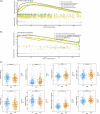Smoking-related epigenetic modifications are associated with the prognosis and chemotherapeutics of patients with bladder cancer
- PMID: 37011378
- PMCID: PMC10074629
- DOI: 10.1177/03946320231166774
Smoking-related epigenetic modifications are associated with the prognosis and chemotherapeutics of patients with bladder cancer
Abstract
Objective: Epidemiologic studies have linked smoking to various malignancies, including bladder cancer, but its underlying biological functions remain elusive. Currently, we aimed to identify the smoking-related epigenetic modifications and disclose their impacts on prognosis and therapies in bladder cancer.
Methods: DNA methylation, transcriptome, and clinical profiles were acquired from The Cancer Genome Atlas (TCGA) using "TCGAbiolinks" Differential expression analyses were performed with "limma" and visualized by the "pheatmap" package. Smoking-related interactions were displayed using Cytoscape. Least absolute shrinkage and selection operator (LASSO) algorithm was for generation of a smoking-related prognostic model. Kaplan-Meier analysis with log-rank test was for survival analysis, followed by a prognostic nomogram. The Gene Set Enrichment Analysis (GSEA) was used for functional analysis. The "oncoPredict" package was applied for drug sensitivity analysis.
Results: We recruited all types of bladder cancers and found that smoking was involved in poor prognosis, with the hazard ratio (HR) of 1.600 (95%CI: 1.028-2.491). A total of 1078 smoking-related DNA methylations (526 hypermethylation and 552 hypomethylation) were identified and 9 methylation-driven genes differentially expressed in bladder cancer. Also, 506lncRNAs (448 upregulated and 58 downregulated lncRNAs) and 102 miRNAs (74 upregulated and 28 downregulated miRNAs) were determined as smoking-related ncRNAs. We then calculated the smoking-related risk score and observed that cases of high risk were predicted with poor prognosis. We constructed a prognostic nomogram to predict the 1-, 3-, and 5-year overall survival rates. Several cancer-related pathways were enriched in the high-risk group, and patients with high-risk were more sensitive to Gemcitabine, Wnt-C59, JAK1_8709, KRAS (G12C) Inhibitor-12, and LY2109761. Whereas, those with low-risk were more sensitive to Cisplatin, AZ960, and Buparlisib.
Conclusions: Totally, we initially identified the smoking-related epigenetic modifications in bladder cancer and constructed a corresponding prognostic model, which was also linked to disparate sensitivities to chemotherapeutics. Our findings would provide novel insights into the carcinogenesis, prognosis, and therapies in bladder cancer.
Keywords: The Cancer Genome Atlas; bladder cancer; chemotherapies; epigenetic modification; prognosis; smoking behavior.
Conflict of interest statement
The author(s) declared no potential conflicts of interest with respect to the research, authorship, and/or publication of this article.
Figures





References
-
- Alessandrino F, Williams K, Nassar AH, et al. (2020) Muscle-invasive urothelial cancer: association of mutational status with metastatic pattern and survival. Radiology 295(3): 572–580. - PubMed
-
- Sung H, Ferlay J, Siegel RL, et al. (2021) Global cancer statistics 2020: globocan estimates of incidence and mortality worldwide for 36 cancers in 185 countries. CA: A Cancer Journal for Clinicians 71(3): 209–249. - PubMed
-
- Dobruch J, Daneshmand S, Fisch M, et al. (2016) Gender and bladder cancer: a collaborative review of etiology, biology, and outcomes. European Urology 69(2): 300–310. - PubMed
-
- Antoni S, Ferlay J, Soerjomataram I, et al. (2017) bladder cancer incidence and mortality: a global overview and recent trends. European Urology 71(1): 96–108. - PubMed
-
- Strope SA, Montie JE. (2008) The causal role of cigarette smoking in bladder cancer initiation and progression, and the role of urologists in smoking cessation. Journal of Urology 180(1): 31–37. ; discussion 37. - PubMed
MeSH terms
Substances
LinkOut - more resources
Full Text Sources
Medical
Research Materials
Miscellaneous

